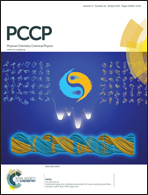Vacancy-induced initial decomposition of condensed phase NTO via bimolecular hydrogen transfer mechanisms at high pressure: a DFT-D study†
Abstract
Density functional theory with dispersion-correction (DFT-D) was employed to study the effects of vacancy and pressure on the structure and initial decomposition of crystalline 5-nitro-2,4-dihydro-3H-1,2,4-triazol-3-one (β-NTO), a high-energy insensitive explosive. A comparative analysis of the chemical behaviors of NTO in the ideal bulk crystal and vacancy-containing crystals under applied hydrostatic compression was considered. Our calculated formation energy, vacancy interaction energy, electron density difference, and frontier orbitals reveal that the stability of NTO can be effectively manipulated by changing the molecular environment. Bimolecular hydrogen transfer is suggested to be a potential initial chemical reaction in the vacancy-containing NTO solid at 50 GPa, which is prior to the C–NO2 bond dissociation as its initiation decomposition in the gas phase. The vacancy defects introduced into the ideal bulk NTO crystal can produce a localized site, where the initiation decomposition is preferentially accelerated and then promotes further decompositions. Our results may shed some light on the influence of the molecular environments on the initial pathways in molecular explosives.


 Please wait while we load your content...
Please wait while we load your content...